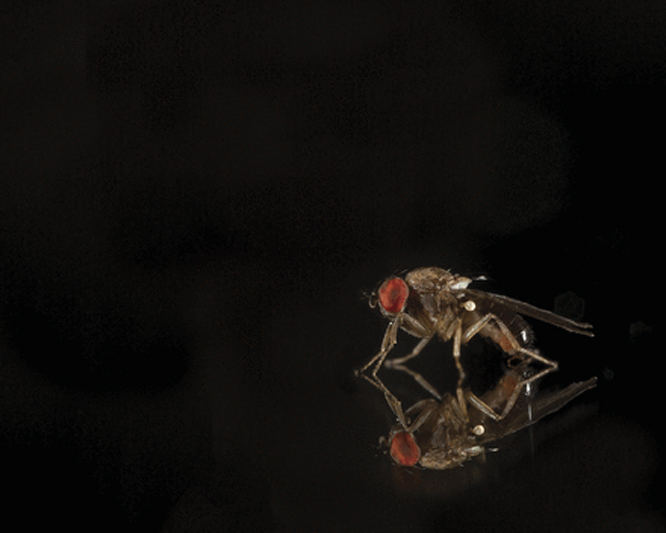The March issue of GENETICS is out now! Check out the highlights below of the full Table of Contents here.
Locally epistatic genomic relationship matrices for genomic association and prediction, pp. 857–871
Deniz Akdemir and Jean-Luc Jannink
In breeding studies a distinction is made between the genetic value (additive + epistatic genetic effects) and the breeding value (additive genetic effects) of an individual, because some of the epistatic genetic effects will be lost due to recombination. Akdemir and Jannink argue that the breeder can take advantage of epistatic marker effects in regions of low recombination. To this end, they develop and illustrate the use of multiple kernel models for genomic prediction and association. The models provide good predictive performance along with useful explanatory information.
An enhanced gene targeting toolkit for Drosophila: Golic+, pp. 683–694
Hui-Min Chen, Yaling Huang, Barret D. Pfeiffer, Xiaohao Yao, and Tzumin Lee
Chen et al. report high-efficiency CRISPR-based gene targeting in Drosophila cystoblasts, which each develop into a single female germ cell and therefore guarantee independent targeting events per individual offspring. Compared to direct embryo injection, the new system allows efficient re-trials of large inserts or difficult loci. The system includes a repressor-based lethality selection to facilitate screening and can be readily scaled up for high-throughput genome editing.
The ABCs of eye color in Tribolium castaneum: orthologs of the Drosophila white,scarlet, and brown genes, pp. 749–759
Nathaniel Grubbs, Sue Haas, Richard W. Beeman, and Marcé D. Lorenzen
The ABC transporters White, Scarlet, and Brown are critical for proper eye pigmentation inDrosophila. Grubbs et al. cloned the three orthologous genes from the beetle Tribolium castaneum, characterized the promoters of all three genes, and analyzed eye-color mutants to identify lesions that will provide a new tool for analysis and genetic transformation. They also consider how these genes and eye pigmentation have changed during insect evolution.
Molecular proxies for climate maladaptation in a long-lived tree (Pinus pinaster Aiton, Pinaceae), pp. 793–807
Juan-Pablo Jaramillo-Correa, Isabel Rodríguez-Quilón, Delphine Grivet, Camille Lepoittevin, Federico Sebastiani, Myriam Heuertz, Pauline H. Garnier-Géré, Ricardo Alía, Christophe Plomion, Giovanni G. Vendramin, Santiago C. González-Martínez
Better understanding adaptive genetic responses to climate change will help predict range shifts and assist management of biological diversity. Jaramillo-Correa et al. identified 18 SNPs associated with climate in maritime pine (Pinus pinaster Aiton), an outcrossing, long-lived, keystone forest tree. Alleles at the candidate loci were successfully used to predict maladaptation to climate in a common garden under hot and dry climate conditions. Populations with low frequencies of locally advantageous alleles showed increased mortality, suggesting that distinct gene pools will decline to different degrees.
The mammalian cervical vertebrae blueprint depends on the T (brachyury) gene, pp.873–883
Andreas Kromik, Reiner Ulrich, Marian Kusenda, Andrea Tipold, Veronika M. Stein, Maren Hellige, Peter Dziallas, Frieder Hadlich, Philipp Widmann, Tom Goldammer, Wolfgang Baumgärtner, Jürgen Rehage, Dierck Segelke, Rosemarie Weikard, and Christa Kühn
Although the vertebral column is highly diversified between vertebrates, the number of cervical vertebrae within mammals has been fixed for more than 200 million years. Kromiket al. report the first known mammalian spontaneous mutation that changes the fundamental seven-cervical-vertebrae blueprint. The mutation alters the T/brachyury gene, which plays a role in neuro-skeletal development. These data show the T protein is directly involved in the maintenance of the mammalian seven-cervical-vertebrae blueprint.
Unusual regulation of splicing of the cholinergic locus in Caenorhabditis elegans, pp.729–737
Eleanor A. Mathews, Gregory P. Mullen, Jacob R. Manjarrez, and James B. Rand
The Cholinergic Gene Locus (CGL) encodes two genes required for release of acetylcholine; one gene is nested within the other, and the two gene products arise by alternative splicing. Mathews et al. report a novel form of splicing regulation in the C. elegans CGL mediated by two sets of complementary sequence elements. These sequence elements are able to form stem-loop structures in the pre-mRNA, which may favor specific alternative splice forms. The authors find comparable CGL elements in most animal phyla genomes, suggesting the mechanism is conserved.
Assessing gene-environment interactions for common and rare variants with binary traits using gene-trait similarity regression, pp. 695–710
Guolin Zhao, Rachel Marceau, Daowen Zhang, and Jung-Ying Tzeng
Accounting for G×E interactions can improve complex trait association studies and our understanding of genetic heterogeneity. However, G×E interactions can be difficult to find, as they require much larger samples and are sensitive to the misspecification of main effects model. These issues are exacerbated when working with binary phenotypes and rare variants. Zhao et al. present a powerful, robust method to evaluate G×E for common or rare variants with binary traits.
PERSPECTIVES
Fruit flies in biomedical research, pp. 639–653
Michael F. Wangler, Shinya Yamamoto, and Hugo J. Bellen
NIH and NSF funding for Drosophila research has declined in recent years, despite the model’s numerous significant contributions to biomedical science. Wangler et al. highlight the strengths of Drosophila and argue the field will continue to reveal important biological insights that can be translated to human disease research. They argue that collaboration between Drosophila geneticists, human geneticists, bioinformaticians, and clinicians will improve the functional annotation of both genomes, providing important data for the diagnosis, study, and treatment of genetic disorders.













